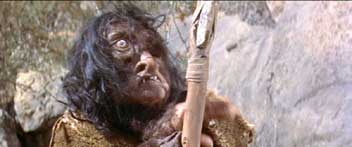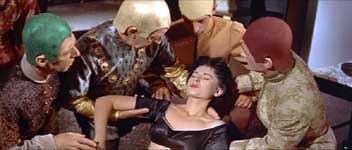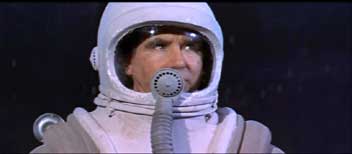 WORLD
WITHOUT END (1956)/SATELLITE IN THE SKY
(1956)
WORLD
WITHOUT END (1956)/SATELLITE IN THE SKY
(1956)Directors: Edward Bernds, Paul Dickson
Warner Home Video/Best Buy
 WORLD
WITHOUT END (1956)/SATELLITE IN THE SKY
(1956)
WORLD
WITHOUT END (1956)/SATELLITE IN THE SKY
(1956)Although initially being released as Best Buy (online and in-store) exclusives, Warner Home Video’s new trio of “Sci-Fi Double Feature” releases fill a cultish void this summer, since the company seems to have abandoned their own “Cult Camp Classics” series and since MGM has unwisely tucked their popular “Midnite Movies” line into hibernation for 2008 (though Midnite Movies merchandise is in full swing this year). This “Sci-Fi Double Feature” boasts two color space flight flicks from the 1950s, both in CinemaScope and both shot in luxurious color.

In WORLD WITHOUT END, mankind’s first space flight to Mars is in the hands of astronauts John Borden (Hugh Marlowe, EARTH VS. THE FLYING SAUCERS), Dr. Eldon Galbraithe (Nelson Leigh), Herbert Ellis (Rod Taylor, still years before his starring role in THE TIME MACHINE) and Hank Jaffe (Christopher Dark), who are dressed in bomber jackets and hunter’s caps rather than fancy spacesuits. On return from circling the red planet, their toy rocketship is forced to land on a strange planet covered in a blanket of snow, but their trek on foot soon uncovers a cave with giant spiders and a race of spear-chucking mutant caveman roaming the land. In a cemetery, headstones with futuristic dates has them speculate that they have been caught in a time warp and are now in Earth’s own atomic war-devastated future (2058 A.D. to be exact). They soon take refuge in an underground civilized city where bland men in skull caps and flirty women in low-cut cocktail dresses reside, and the four visitors try and convince them to come out of their hole in the ground and overcome the “beasts” that dwell above, as well as get some sun.
 Yet
another science fiction programmer from the “poverty row” confines
of Allied Artists, WORLD WITHOUT END looks a bit more expensive than usual because
of Technicolor and Scope photography, but everything else should give it away,
including the limited sets, a wire-dangled rocket, bad monster make-up which
is rarely shown in close-up, pillowy giant spiders that look like they were
left over from CAT WOMEN ON THE MOON and the familiar Bronson Canyon outdoor
locations. This all adds up to a lot of fun, and despite some talky stretches,
it's an entertaining little film, a must-see for fans of 1950s sci-fi that mixes
camp (some of the dialog will induce belly laughs) with several novel ideas,
some of which would be explored years later with the PLANET OF THE APES films.
Yet
another science fiction programmer from the “poverty row” confines
of Allied Artists, WORLD WITHOUT END looks a bit more expensive than usual because
of Technicolor and Scope photography, but everything else should give it away,
including the limited sets, a wire-dangled rocket, bad monster make-up which
is rarely shown in close-up, pillowy giant spiders that look like they were
left over from CAT WOMEN ON THE MOON and the familiar Bronson Canyon outdoor
locations. This all adds up to a lot of fun, and despite some talky stretches,
it's an entertaining little film, a must-see for fans of 1950s sci-fi that mixes
camp (some of the dialog will induce belly laughs) with several novel ideas,
some of which would be explored years later with the PLANET OF THE APES films.

Director Edward Bernds (who also concocted the screenplay) is mostly associated with The Three Stooges, but he did dabble in science fiction, and would soon go on to helm a better-known yet sillier sort of follow-up with QUEEN OF OUTER SPACE (1958), also shot in Cinemascope and color, as well as RETURN OF THE FLY (1959). The attractive female stars include Nancy Gates, Shawn Smith (aka Shirley Patterson, THE LAND UNKNOWN, IT! THE TERROR FROM BEYOND SPACE) and Lisa Montell (SHE GODS OF SHARK REEF). As an unethical undergrounder who attempts to frame the heroes for murder, Booth Colman is probably best known as Dr. Zaius on the short-lived “Planet of the Apes” TV series, but he remains a popular character actor on television to this day, recently appearing on “My Name Is Earl.”
 SATELLITE
IN THE SKY tells of the first manned rocket/satellite into space, being launched
from England. Aboard for the ride are Commander Michael Haydon (Kieron Moore,
DR. BLOOD’S COFFIN), Professor Merrity (Donald Wolfit, BLOOD OF THE VAMPIRE),
Jimmy Wheeler (Bryan Forbes, QUATERMASS 2), Larry Noble (Jimmy Hanley, Hammer’s
THE LOST CONTINENT) and Lefty Blake (Barry Keegan). Not long after the mission
is underway, a stowaway is discovered hiding onboard in the form of gutsy female
reporter Kim Hamilton (Lois Maxwell, well known as “Miss Moneypenney”
in the James Bond series). The crew’s assignment is to test out a tritonium
bomb in outer space, but the deadly explosive affixes itself to the side of
the rocket/satellite and must be defused or else…
SATELLITE
IN THE SKY tells of the first manned rocket/satellite into space, being launched
from England. Aboard for the ride are Commander Michael Haydon (Kieron Moore,
DR. BLOOD’S COFFIN), Professor Merrity (Donald Wolfit, BLOOD OF THE VAMPIRE),
Jimmy Wheeler (Bryan Forbes, QUATERMASS 2), Larry Noble (Jimmy Hanley, Hammer’s
THE LOST CONTINENT) and Lefty Blake (Barry Keegan). Not long after the mission
is underway, a stowaway is discovered hiding onboard in the form of gutsy female
reporter Kim Hamilton (Lois Maxwell, well known as “Miss Moneypenney”
in the James Bond series). The crew’s assignment is to test out a tritonium
bomb in outer space, but the deadly explosive affixes itself to the side of
the rocket/satellite and must be defused or else…

SATELLITE IN THE SKY is evidence that the Brits were not well accomplished at producing science fiction films in the 1950s, with the exception of Hammer’s early “Quatermass” outings. Most of the output was dull melodrama (Terence Fisher’s SPACEWAYS) or all-out camp fests (DEVIL GIRL FROM MARS), with SATELLITE being more of the former than the latter. It takes more than a half hour for any space travel to take place, and when it does, it’s an endlessly talky affair, with the crew bickering at each other or standing around drinking coffee and eating sandwiches. The special effects, including a lot of miniature and matte work, is actually better then most of the film’s American counterparts of the time (effects man Wally Veevers would later work on 2001: A SPACE ODYSSEY), and the familiar cast of British character actors are first-rate, but it’s still an endurance test. If you thought Donald Wolfit was restrained in BLOOD OF THE VAMPIRE, wait until you see how animated he is here, overacting with every bit of trite dialog he utters. His performance is one of the highlights of the film. Look quickly for an uncredited bit by a very young Bernard Bresslaw as a technician in a white jumper.
 Since
both films were shot in CinemaScope, it’s a pleasure to finally see them
in nice widescreen transfers. Previously available on VHS in a pan and scan
transfer, WORLD WITHOUT END looks fantastic here, presented its original 2.35:1
Cinemascope aspect ratio with anamorphic enhancement. The Technicolor photography
is vibrant, detail is excellent, and there is very little in the way of grain
or print blemishes. The mono audio has clear dialog and renders Leith Stevens’
classic score nicely. While not as polished-looking as WORLD, SATELLITE IN THE
SKY still looks good, also presented in its original 2.35:1 aspect ratio with
anamorphic enhancement. Colors are mostly bold, though on some occasions looking
slightly muted. The image is for the most part clean, though there are some
print blemishes abound as well as some picture softness, but it still looks
a million times better than the bootleg videos that had been in circulation.
The mono audio is also fine and free of any noticeable distortion. Both films
have optional English and French subtitles. The two films are presented on a
one-sided dual-layered disc without chapter menus or extras.
(George
R. Reis)
Since
both films were shot in CinemaScope, it’s a pleasure to finally see them
in nice widescreen transfers. Previously available on VHS in a pan and scan
transfer, WORLD WITHOUT END looks fantastic here, presented its original 2.35:1
Cinemascope aspect ratio with anamorphic enhancement. The Technicolor photography
is vibrant, detail is excellent, and there is very little in the way of grain
or print blemishes. The mono audio has clear dialog and renders Leith Stevens’
classic score nicely. While not as polished-looking as WORLD, SATELLITE IN THE
SKY still looks good, also presented in its original 2.35:1 aspect ratio with
anamorphic enhancement. Colors are mostly bold, though on some occasions looking
slightly muted. The image is for the most part clean, though there are some
print blemishes abound as well as some picture softness, but it still looks
a million times better than the bootleg videos that had been in circulation.
The mono audio is also fine and free of any noticeable distortion. Both films
have optional English and French subtitles. The two films are presented on a
one-sided dual-layered disc without chapter menus or extras.
(George
R. Reis)